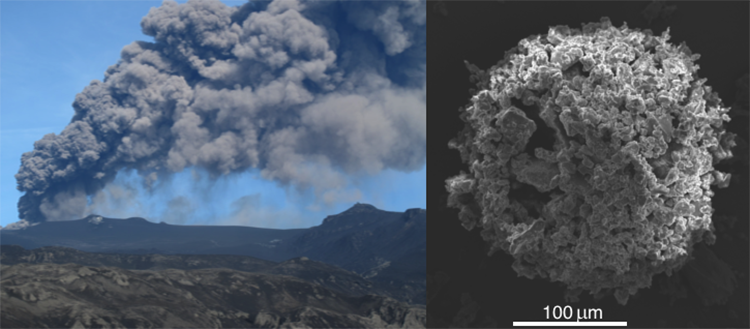How do you know where volcanic ash will end up?
A UNIGE team studied the ash from volcanic eruptions and discovered two effects of ash sedimentation that will improve our ability to predict the danger posed by volcanic ash clouds.

Volcanic plume associated with the April-May 2010 eruption of Eyjafjallajökull volcano (Iceland) and Scanning Electron Microscope image of a typical ash cluster made of micrometric volcanic particles collected on an adhesive paper during fallout. © UNIGE, Costanza Bonadonna
When the Eyjafjallajökull volcano in Iceland erupted in April 2010, air traffic was interrupted for six days and then disrupted until May. Until then, models from the nine Volcanic Ash Advisory Centres (VAACs) around the world, which aimed at predicting when the ash cloud interfered with aircraft routes, were based on the tracking of the clouds in the atmosphere. In the wake of this economic disaster for airlines, ash concentration thresholds were introduced in Europe which are used by the airline industry when making decisions on flight restrictions. However, a team of researchers, led by the University of Geneva (UNIGE), Switzerland, discovered that even the smallest volcanic ash did not behave as expected. Its results, to be read in the journal Nature Communications, will help to refine the way that volcanic ash is represented in forecasting models used by the VAACs, which must react in real-time to provide useful advice during a volcanic eruption.
The eruption of Iceland’s Eyjafjallajökull volcano in 2010 not only disrupted global air traffic, but also called into question the functioning of the forecast strategies used by the VAACs, based only on the spatial tracking of the ash cloud. A meeting of experts refined the strategies based on ash concentration thresholds and enabled flights to resume more quickly, while ensuring the safety of passengers and flight personnel.
“During a volcanic explosive eruption, fragments ranging from a few microns to more than 2 metres are ejected from the volcanic vent,” explains Eduardo Rossi, a researcher at the Department of Earth Sciences of the UNIGE Faculty of Sciences and the first author of the study. The larger the particles, the faster and closer to the volcano they fall, reducing the concentration of ash in the atmosphere. “This is why the new strategies have integrated concentration thresholds better defining the dangerousness for aircraft engines. From 2 milligrams per cubic metre, airlines must have an approved safety case to operate,” says the Geneva-based researcher.
Particle aggregates that impact predictive models
Despite existing knowledge about the ash clouds, several open questions remained unanswered after the 2010 Eyjafjallajökull eruption, including the discovery of particles in UK that were much larger than expected. “We wanted to understand how this was possible by accurately analysing the ash particles from the Sakurajima volcano in Japan, which has been erupting 2-3 times a day for more than 50 years,” says Costanza Bonadonna, a professor in the Department of Earth Sciences at UNIGE.
By using adhesive paper to collect the ash before it hit the ground, the team of scientists had already observed during the Eyjafjallajökull eruption how micrometric particles would group together into clusters, which, after the impact with the ground, were destroyed. “It plays an important role in the sedimentation rate, notes Eduardo Rossi. Once assembled in aggregates, these micrometre particles fall much faster and closer to the volcano than the models predict, because they are ultimately heavier than if they fell individually. This is called premature sedimentation. ”
The rafting effect, declared impossible by theory
In Japan the UNIGE team made a new important discovery: the observation of the rafting effect. Using a high-speed camera, the volcanologists observed the sedimentation of the ash in real-time and discovered previously unseen aggregates called cored clusters. “These are formed by a large particle of 100-800 microns – the core – which is covered by many small particles less than 60 microns, explains Costanza Bonadonna. And this external layer of small particles can act like a parachute over the core, delaying its sedimentation. This is the rafting effect. ”
This rafting effect had been theoretically suggested in 1993, but finally declared impossible. Today, its existence is well and truly proven by direct observation and accurate theoretical analysis, made possible by high-speed camera. “Working with Frances Beckett of the UK Met Office, we have carried out several simulations that have enabled us to answer the questions raised by the eruption of Eyjafjallajökull and the unexplained discovery of these oversized ash particles in UK. It was the result of this rafting effect, which delayed the fall of these aggregates,” enthuses Eduardo Rossi.
Now that the ash aggregates, the cored clusters and the rafting effect have been studied, it is a matter of collecting more accurate physical particle parameters so that one day they can be integrated into the operational models of the VAACs, for which size and density play a crucial role in calculating the concentration of ash in the atmosphere.
